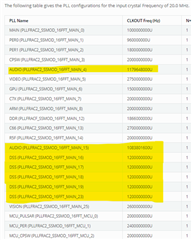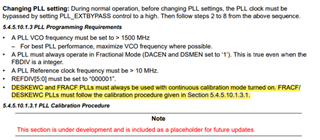Dear Ti-Team,
we're currently working on PLL configuration routine (without DMSC due to our project restrictions) and faced some difficulties.
Could you please clarify the following questions:
- Acc. to the TRM (SPRUIL1C) chapter "5.4.5.10.1.3" a PLL VCO must be >1500MHz (see below), but it contradicts to the TI default configuration:


Q1: Is this requirement regarding minimal PLL VCO valid or not? -
According with the TRM, DSMEN and DACEN fields of PLL CTRL register have to be always set:

Documentation suggests PLL type must always operate in fractional mode which makes sense as DACEN and DSMEN are enabled, however, TI default values have DSMEN cleared for the MCU_PLL0 and PLL0, suggesting they are operating in integer mode.Furthermore, MCU_PLL0 and PLL0 have their fractional divider set to 0, which also suggest the clear of DSMEN.
Q2: Is documentation correct? Should DSMEN and DACEN be set to 1 by default? As far as we understand it, when fractional divider is set to 0, DSMEN should be cleared.
-
We're trying to configure register PLLDIV2 to configure the MCU_SYSCLK0 and MAIN_SYSCLK0 clocks.
However, we're failing to understand PLLDIV2 functionality. Documentation does not give a lot of details, CTT also seems not having information about it.
As far as we understand, if PLLSELB of PLLCTRL value is set to zero, only PLLDIV1 is used and PLLDIV2 is not relevant.
Q3: Should the PLL Controller register PLLDIV2 be configured? What is its functionality? - The following extract from the TRM requires calibration procedure to be done for a PLL:

Calibration procedure is not present in either “B” or “C” revisions of the TRM.
Q4: What is the correct calibration procedure? - Chapter "5.4.5.10.4 Entire Sequence for Programming PLLCTRL, HSDIV, and PLL” of TRM requires to have a delay after specific steps. However delay values are not specified.
Q5: Which constraints for these delay have to be taken into account while programming PLLs? - Chapter "5.4.5.10.4 Entire Sequence for Programming PLLCTRL, HSDIV, and PLL” of TRM contains two steps "Configure PLL dividers" and "Configure "random" PLL controls".
In this steps some of the settings duplicate each other, e.g. REF_DIV = 1, POST_DIV1 = 1 and POST_DIV2 = 1.
Q6: Is it really necessary to repeat some settings? Should these two steps be performed in the order defined in the TRM (with doubled settings of some regs)?
Q7: POST_DIV1 =1 and POST_DIV2 = 1 is not traceable to default TI PLL configuration (not always value 1 is used). Is it a typo?
Best regards,
Dmitry

